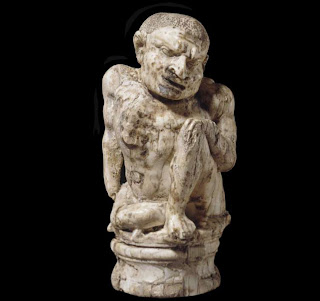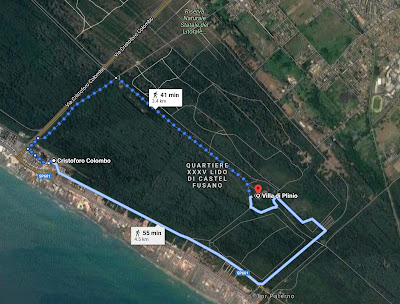 |
Headed by Caroline Bristow of the Cambridge Schools Classics Project, this online course would be based around the ancient Roman inhabitants of the so-called House and Bar of Amarantus in Pompeii. Archaeologists Andrew Wallace-Hadrill and Sophie Hay would provide the physical evidence; Greek Myth Comix artist and Classics teacher Laura Jenkinson would illustrate it; historians like Olivia Elder would advise and I would write a narrative incorporating some of what we know about the residents.
The story would be fictional, showing daily life of a middle-class Pompeian family, but based on the archaeology, especially the house plan, artefacts, graffiti and plant remains. Caroline Bristow wanted six modules each based around a specific topic, such as Roman Beliefs and Ancient Food.
 |
| signet ring with mule, photo by Chris Warde-Jones |
Instead of making up my own plot, as I usually do, I had to stick to the six specific topics. I was also given a wish-list of scenes and ideas to incorporate, especially by Dr Sophie Hay, who helped excavate the site for several years and discovered the remains of a mule and dog in one of the front rooms! I felt like writer on a TV show working with a room full of collaborators. We had to decide the age and status of our hero Amarantus, when to set the story, the time span of the narrative and other elements of the plot, (like the names of the mule and dog).
Most books or stories about Pompeii conclude with a bang: the town’s destruction by the eruption of Vesuvius in 79 CE. However, archaeologist Sophie Hay was keen to set our story seventeen years before the eruption when a sizeable earthquake rocked Pompeii. I suggested we begin the book with a bang: the earthquake. But Dr Sophie (as we call her) was adamant that the earthquake occur halfway through. After a few days of sulking, I realised she was right. There is often a dramatic event at the halfway point of a story and this could be it. It could also show that what seems to be a disaster for many can be a blessing for a few. The earthquake becomes crucial for Amarantus’s personal journey from slave to successful freedman.
 |
| Brainstorming ideas at my London flat in August 2018 |
The earliest age that a slave can be manumitted is thirty. So we decided to make Amarantus thirty. Graffiti shows him with spiky hair and a bulbous nose. So we incorporated those elements into our story. And what about the dead mule and dog? I couldn’t bear to write a story with unhappy animals so decided to give them to Amarantus and also to make him soft-hearted, which I’m pretty sure was not the case for most ancient Romans.
Once we agreed these basic elements, I was given free rein. My main motivation as a writer of historical fiction has always been to transport readers back in time, using soundscape, smellscape, touch and taste as well as visual descriptions. That is what I wanted to do here. I also set myself the challenge of making each chapter unique and compelling. Finally, I wanted to show how like us the ancients were, but with a surprise or even sting at the end of each tale, reminding people how unlike us they were.
I wrote the first draft in a few months, finishing it by Christmas of 2018.
 |
| View of the crossroads fountain, seen from the bar of Amarantus |
But I wasn’t done yet. Oh no.
Esteemed professor Andrew Wallace-Hadrill whom I have nicknamed the ‘Myth Buster’ challenged many of my decisions. Did they really have ‘wheels of cheese’ in Roman times? Is there actual evidence of betrothal rings? We had to find evidence! I too am obsessed with accuracy and I long to know what it was really like in the past, so I didn’t mind at all.
 |
| Amarantus with a 'wheel of cheese' by Laura Jenkinson-Brown |
Because this story is set in the ‘universe’ of Caecilius, Metella, Quintus et al from the original Cambridge Latin Course book, we decided to put in a few ‘Easter Eggs’. I believe James Watson suggested a cameo by baby Quintus.
Olivia Elder, our graffiti expert, requested graffiti only found in Pompeii and the environs. This included a few quotes from Virgil. Again, I was happy to comply.
 |
| Model of Vatia's garden by Laura Jenkinson-Brown |
Then in came Laura Jenkinson-Brown, our amazing Classics teacher by day and illustrator by night. As she began to draw the scenes, this raised a myriad of new questions. How BIG was a wheel of cheese? What does a wineskin actually look like? Where would the shadows fall in a west-facing dining room? Laura went as far as constructing 3D cardboard models to better depict some of the scenes and even persuaded her delightful husband Sy to pose with soft toys while she sketched the characters.
 |
| Dr Sophie digging in Pompeii! |
The Amarantus Project turned out to be one of the most enjoyable projects I have ever worked on. I would like to thank the CSCP team and all the other brilliant and meticulous scholars who helped me write this story. This truly is a labour of love. I’m sure my collaborators would all agree when I say that we hope this book will grip middle grade readers and get them as excited about Pompeii and the past as we are.
P.S. You can now buy the book Amarantus and his Neighbourhood from Amazon. If you want to dive down more rabbit holes with us, go to the interactive site, www.cambridgeamarantus.com, where there is evidence for almost every line in this book.
 |
| Sophe at Pompeii's port, my fave illustration by Laura Jenkinson-Brown |
P.P.S. Observant readers will spot that street urchin Sophe resembles Dr. Sophie Hay in certain respects. This was a clever visual tribute by Laura Jenkinson-Brown, who also represents herself as one of the characters. Can you guess which one?




































